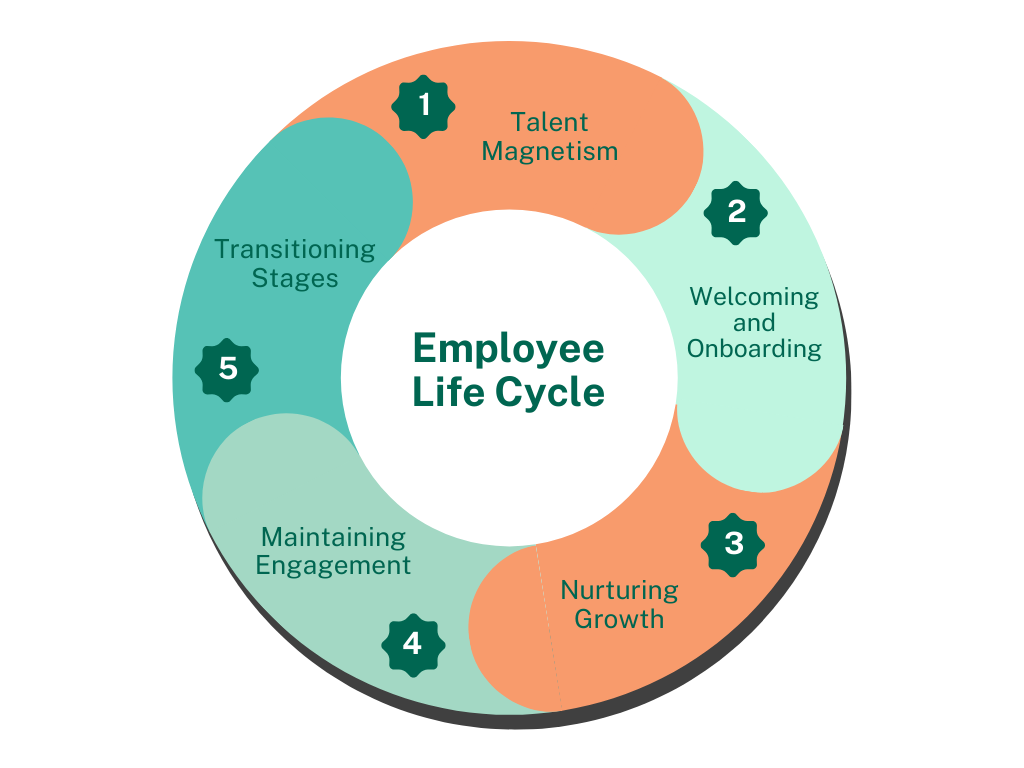Grasping the intricacies of the employee life cycle stands as a cornerstone in the realm of effective human capital management (HCM). In my experience, it has become evident that HR professionals who deeply understand each phase of this cycle are better equipped to elevate their organization’s approach to talent management from hiring to long term retention.
By aligning HR processes with the following stages, organizations can ensure a positive experience for current employees and new hires alike, fostering a great place to work and grow. This comprehensive guide explains the different stages of the employee life cycle, emphasizing its significant impact on everything from employee engagement to retention rates.
The Employee Life Cycle: A Closer Look
The employee life cycle encompasses various stages an employee goes through during their tenure at an organization.

Talent Magnetism
The recruitment stage of the employee life cycle begins with attracting qualified candidates. Here, it’s crucial to craft job descriptions that resonate with job seekers and reflect your company values. A strong employer brand not only appeals to potential employees but also sets the stage for a positive work environment, crucial for long-term employee retention.
Welcoming and Onboarding
Once the hiring process culminates in a job offer, the onboarding process takes center stage. This phase is critical in shaping the employee experience, especially on the first day. Effective onboarding ensures new employees feel part of the team and understand their role in the company culture, paving the way for higher job satisfaction and employee performance. To make onboarding more effective, organizations should develop a robust process lasting from 90-days up to 12 months. This longer process is sometimes referred to as everboarding.
Nurturing Growth
As part of employee life cycle management, providing development opportunities for skill enhancement is key. HR teams must focus on performance management. Ensuring that every employee–from new hires to long-standing team members–has access to career development resources. This approach not only enhances the employee journey but also contributes to a robust talent pool within the organization.
Maintaining Engagement
Employee engagement is a continuous process. HR professionals must seek honest feedback through regular employee feedback mechanisms. This not only improves the overall employee experience but also aids in adjusting HR processes to better suit the needs of the workforce.
Transitioning Stages
At various stages in the employee life cycle, employees might transition to a new role or leave the organization. HR departments play a crucial role in these transitions, whether it’s providing support for a new position or conducting an exit interview for former employees. Understanding the reasons behind employee turnover through honest feedback during exit interviews can offer valuable insights for improving retention strategies.
Impact on Human Capital Management
The employee life cycle significantly impacts various aspects of human capital management:
- Strategic planning helps organizations understand each stage and enables HR professionals to align human capital strategies with business objectives. It helps in forecasting talent needs and developing succession plans.
- By recognizing the different needs at each stage, HR can tailor approaches for all aspects of talent management: acquisition, development, and retention.
- A positive employee experience at each stage of the cycle enhances employee engagement, productivity, and loyalty.
- Tracking metrics at each stage of the employee life cycle can pave the way for data informed decision-making. This includes turnover rates, time-to-hire, and employee satisfaction scores.
- Effective management of the employee life cycle can lead to cost savings by reducing turnover rates and improving employee performance.
The employee life cycle stands as a pivotal element in human capital management. HR professionals who adeptly navigate its various stages can significantly impact employee satisfaction and retention. By ensuring a positive experience from the recruitment stage through to the onboarding phase and beyond, organizations can retain top talent and maintain a high level of employee engagement. It’s important to remember that the true strength of your organization is embodied in your employees at every stage of their journey.
For those looking to further refine these strategies and maximize the potential of their human capital, we offer expert services with tailored solutions that can provide the support and insights needed to navigate the complexities of each stage in the employee life cycle effectively. Learn more about us!

